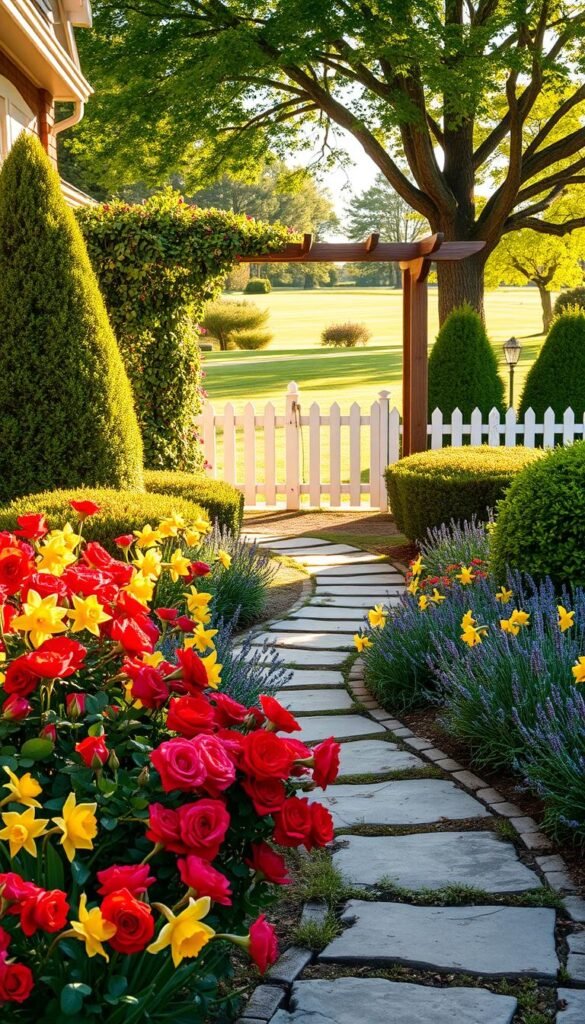Your home’s exterior speaks volumes before anyone steps inside. A vibrant outdoor space acts like a handshake—warm, inviting, and full of character. With thoughtful design, even modest areas become eye-catching displays that reflect your unique taste.
Strategic plant choices matter more than size or budget. Focus on colors and textures that harmonize with your house’s style. For example, cottage-style blooms suit traditional homes, while sleek succulents enhance modern architecture.
Consider sunlight patterns and local climate when selecting greenery. Native plants often thrive with less effort, saving you time and resources. Pairing species in creative containers adds dimension without overwhelming limited spaces.
Year-round appeal comes from mixing perennials with seasonal accents. Evergreen shrubs provide structure, while annuals deliver bursts of color. Remember: a well-planned layout reduces maintenance while maximizing visual impact.
Whether you’re updating a suburban lawn or a city plot, the goal remains the same—create a welcoming atmosphere that leaves a lasting positive impression. Start small, experiment with textures, and watch your outdoor area transform.
Setting the Stage: Your Front Yard as a Welcoming Canvas
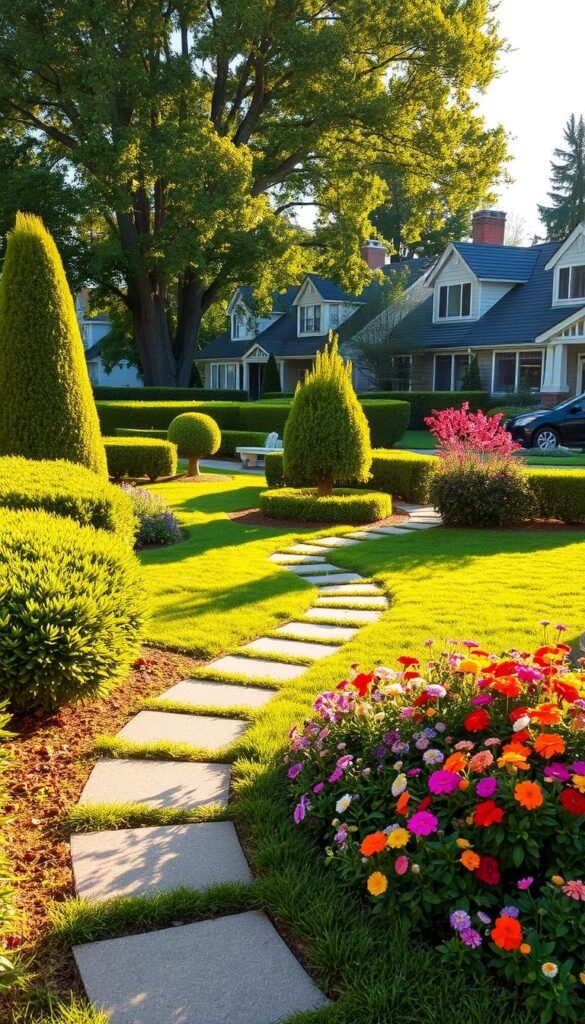
Your property’s curb appeal begins with understanding its unique layout and natural features. Like an artist studying a blank canvas, observe how sunlight dances across your space at different times. Soil quality and drainage patterns act as invisible brushstrokes that determine what will flourish.
Understanding Your Space and Light Conditions
Track sunlight patterns for 24 hours using your phone’s camera. Notice how shadows from buildings or trees create microclimates. These observations help match plants to their ideal growing spots, saving you from wilted blooms later.
Your USDA zone isn’t just a number—it’s a roadmap for plant survival. Pair this knowledge with simple soil tests (available at garden centers) to avoid costly mismatches. Remember: thriving plants need less care, letting you enjoy rather than labor.
Identifying Key Design Areas
Focus on three zones that guests naturally notice:
- Entry paths guiding visitors to your door
- Window frames needing scale-appropriate greenery
- Natural slopes or dips offering creative elevation opportunities
Anticipate growth spurts! That cute 12″ shrub could become a 6′ wall blocker. Use this quick-reference table when planning:
| Light Condition | Plant Type | Mature Height |
|---|---|---|
| Full Sun | Lavender | 24-36″ |
| Partial Shade | Hostas | 12-48″ |
| Full Shade | Fern varieties | 18-60″ |
Document seasonal changes with dated photos. Notice where puddles form after storms or which areas bake in summer heat. These details transform guesswork into strategic design choices.
Selecting the Perfect Plants for Color and Texture
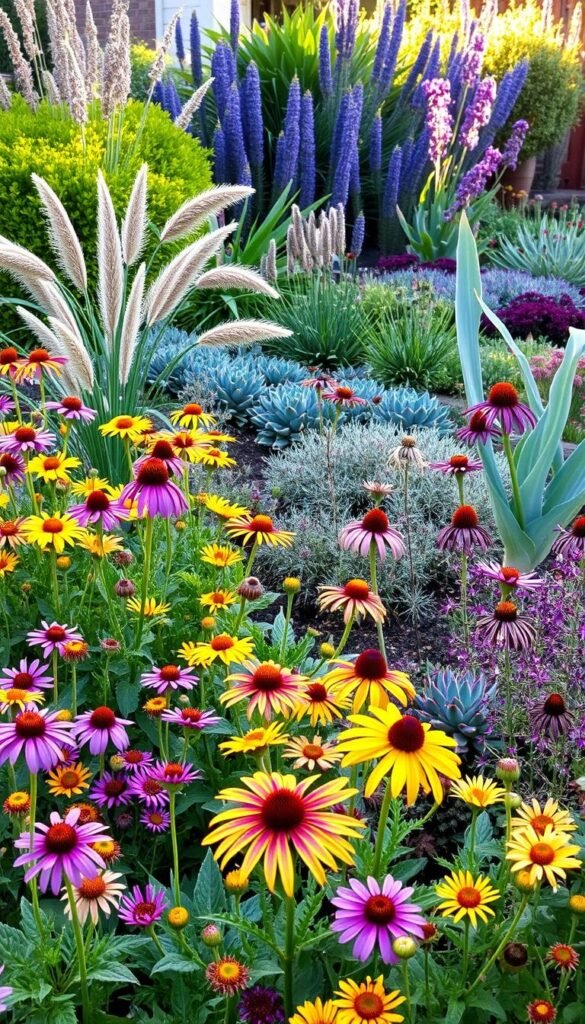
The right greenery transforms ordinary spaces into living art. Focus on varieties that balance beauty with practicality, creating layers of interest while respecting your time and local growing conditions.
Low-Maintenance Annuals and Perennials
Hydrangeas steal the show with their oversized blooms, needing just one yearly trim. Pair them with daylilies for a fireworks display of summer hues—these hardy perennials multiply yearly, covering more ground with minimal care.
Evergreen shrubs like hebe keep your design structured through winter’s gray days. Their subtle flowers add delicate texture without demanding constant attention. For spring fragrance, Chinese fringe shrub delivers aromatic blossoms that linger like nature’s perfume.
Annuals offer quick color updates. Tuck petunias into pots near entryways or line walkways with geraniums. These seasonal stars let you experiment with bold shades without long-term commitment.
Choosing Plants That Thrive in Your USDA Zone
Your zip code holds the key to plant success. Check your USDA zone to avoid frost casualties or heat-stressed specimens. Native species often adapt better, reducing water needs and pest issues.
Mix textures for year-round drama: feathery grasses beside glossy-leaved shrubs, or spiky succulents contrasting with velvety lamb’s ear. This approach keeps eyes moving across your landscape even when blooms fade.
Remember: thriving plants need less babysitting. Invest time upfront in soil preparation and strategic placement, then enjoy seasons of effortless beauty.
Creating a Cozy Focal Point with Eye-Catching Features
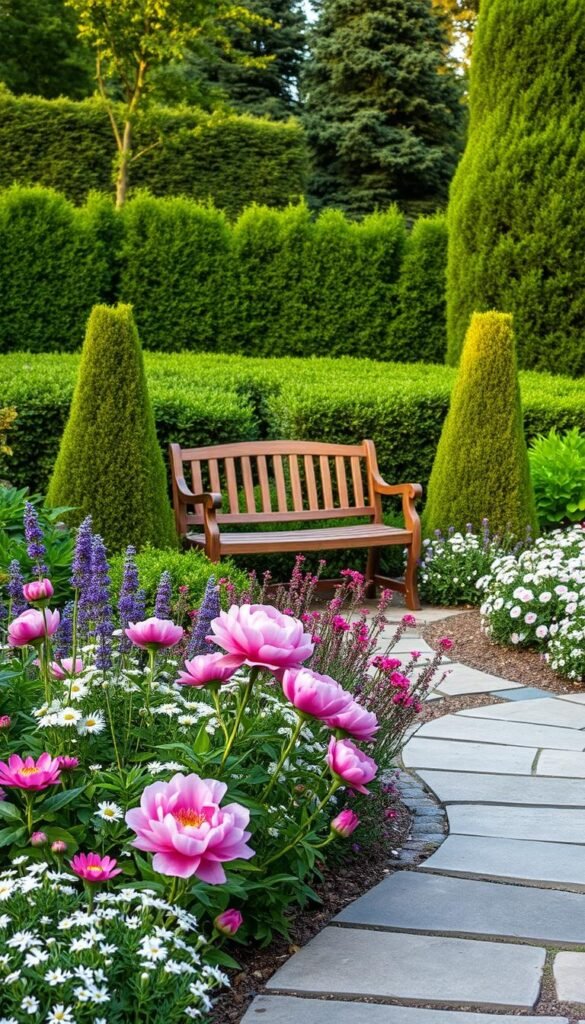
The secret to unforgettable curb appeal lies in crafting intentional moments that capture attention. Start by choosing one standout element that reflects your personality while harmonizing with your home’s architecture.
Using Ornamental Trees, Shrubs, and Sculptural Elements
Four-season trees act as living sculptures. Dogwoods dazzle with spring flowers and winter berries, while Japanese maples offer fiery fall foliage. Even compact spaces shine with dwarf varieties like ‘Stella’ cherry trees, which stay under 10 feet tall.
Shrubs provide structure. Try evergreen boxwoods for crisp lines or hydrangeas for summer drama. Pair them with ornamental grasses like feather reed grass—their swaying plumes add motion and soften hard edges.
Non-plant elements create instant focal points. A stone obelisk surrounded by creeping thyme or a weathered bench nestled among hostas invites exploration. Keep scale in mind: small yards need delicate features, while sprawling spaces can handle bold statements.
Remember these tips for balance:
- Place your focal point where natural sightlines converge
- Use contrasting textures to make elements pop
- Ensure features complement—not compete with—your front house style
By blending living and crafted elements, you’ll create visual interest that evolves beautifully through every season.
Designing with Curb Appeal in Mind
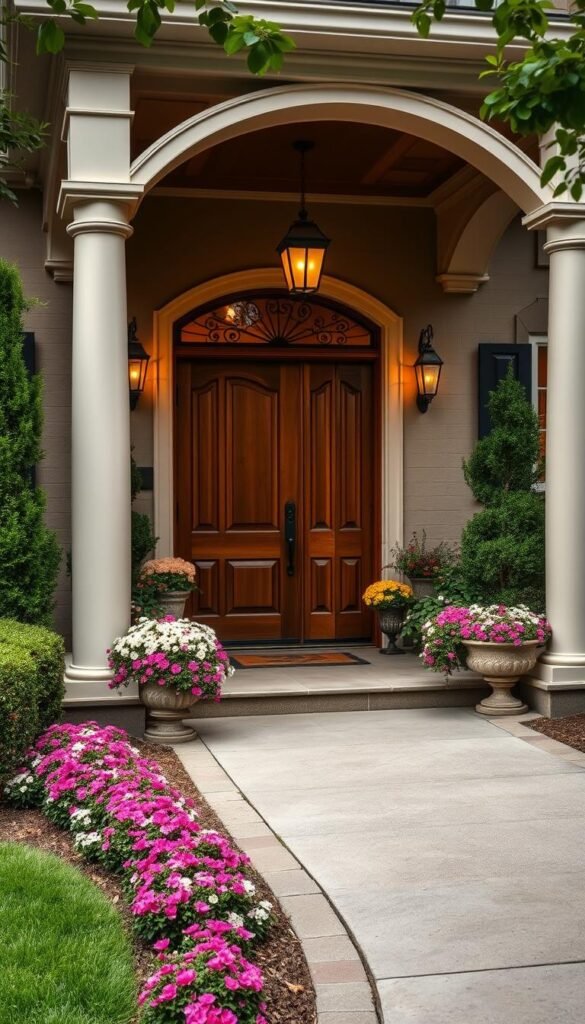
Your entryway sets the tone for your entire property. Thoughtful details here create instant charm while guiding visitors toward your home. A few well-chosen elements can elevate ordinary spaces into memorable introductions.
Enhancing Entryways with Planter Boxes and Welcome Signs
Flanking your front door with matching containers creates visual harmony. Choose cedar or composite boxes that withstand weather while complementing your home’s exterior. Fill them with seasonal blooms like pansies in spring or ornamental kale for winter frosts.
Pair these with a personalized welcome sign using durable materials like slate or treated wood. Mount it directly on the planter or position it nearby. This combo balances practicality with personality—guests instantly recognize your address while admiring your whimsical cottagecore vibe.
Symmetry matters here. Identical planters on either side of steps or pathways signal intentional design. Repeat colors from your house trim in flower selections to unify the look. For evening charm, add solar-powered lanterns that cast warm glows on your arrangements.
Rotate plants quarterly to maintain fresh curb appeal. Summer petunias swap neatly for fall mums, while evergreen sprigs keep winter displays lively. Quality materials ensure your setup stays attractive through countless seasons without constant repairs.
Front Yard Flower Garden: Making a Memorable First Impression
Color acts like a visual handshake for your outdoor space—it shapes perceptions before guests reach your doorstep. Thoughtful combinations create rhythm and depth, transforming ordinary plantings into cohesive displays that captivate throughout the seasons.
Essential Tips for a Standout Garden
Start with the color wheel as your secret weapon. Complementary pairs like violet asters with golden marigolds create electric energy. For subtle elegance, try monochromatic themes—imagine snow-white peonies dancing with ivory clematis.
“Foliage provides the foundation—blooms are the fireworks. Without structural greens, even vibrant flowers lose their impact.”
Triadic schemes offer balanced excitement. Picture coral geraniums, sky-blue salvias, and burnt-orange daylilies working together. These combinations keep eyes moving without chaos. Use this reference table to plan your palette:
| Scheme Type | Color Pairing | Plant Examples |
|---|---|---|
| Complementary | Purple + Yellow | Lavender, Black-Eyed Susan |
| Monochromatic | White Variations | Shasta Daisy, Baby’s Breath |
| Triadic | Pink/Blue/Orange | Hydrangea, Lobelia, Marigold |
Balancing Colors and Foliage for Dynamic Impact
Leaves work overtime when blooms fade. Burgundy heucheras and silver artemisias add depth between flowering cycles. Mix textures too—velvety lamb’s ear beside spiky yucca creates tactile interest.
Time your plantings like a pro. Early tulips hand off to summer phlox, followed by autumn sedum. This succession maintains color flow. Remember: bold zinnias pop against evergreen hedges, while pastel roses shine beside gray-toned grasses.
Keep 60% of your design in neutral greens and whites. Use remaining space for accent hues. This ratio prevents sensory overload while letting your favorite flowers take center stage.
Mixing Colors and Textures for Visual Interest
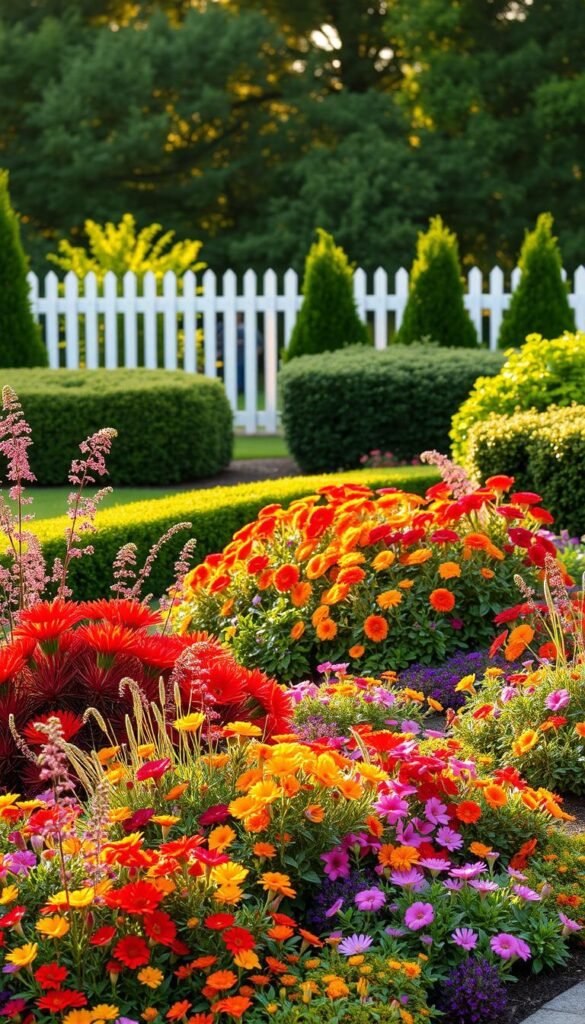
A landscape’s true magic emerges when colors converse and textures collide in purposeful harmony. Thoughtful combinations transform ordinary beds into living tapestries that captivate from every angle.
Coordinating Color Palettes Across Beds
Start by selecting three core hues that complement your home’s exterior. Repeat these shades in different beds to create rhythm. For example, pair sunset-orange marigolds with violet salvias in one area, then echo those tones elsewhere with tulips or autumn joy sedum.
Use this simple reference table to balance your palette:
| Dominant Color | Accent Hue | Foliage Texture |
|---|---|---|
| Deep Purple | Golden Yellow | Feathery Artemisia |
| Soft Pink | Silver-Green | Spiky Yucca |
| Crisp White | Burgundy | Velvety Lamb’s Ear |
Texture mixing adds depth where color alone falls short. Combine spiky dracaena leaves with mounding begonias, then underplant with creeping thyme. This layered approach engages touch as much as sight.
“Texture is color’s silent partner—it amplifies visual impact even when blooms fade.”
Three pro tips for cohesive designs:
- Mirror your front door’s hue in at least two beds
- Use evergreen shrubs as neutral anchors between color bursts
- Group plants in odd numbers (3-5 per cluster) for natural flow
Seasonal transitions become seamless when you plan succession blooms. Early crocuses make way for summer zinnias, while chrysanthemums take center stage in fall. Through every phase, contrasting textures keep beds lively.
Embracing Seasonal Changes for Year-Round Beauty
A truly captivating outdoor space evolves gracefully with each passing month. By aligning your plant choices with nature’s calendar, you’ll maintain visual interest even during quieter seasons. Start by mapping bloom times and pairing early performers with late-show stoppers for continuous color.
Planning for Bloom Cycles and Evergreen Structure
Stagger flowering plants to ensure something always catches the eye. Crocuses and daffodils herald spring, while asters and chrysanthemums close the autumn show. Evergreen shrubs like juniper or holly act as living bookends, framing these seasonal stars.
Mix perennials with self-seeding annuals for effortless variety. Snapdragons reseed naturally, filling gaps with cheerful spikes. Document bloom periods in a simple chart—this helps spot gaps in your yard’s yearly performance.
Maximizing Yearly Visual Impact
Layer plants by height and texture to create depth. Tall ornamental grasses sway behind mid-sized coneflowers, while creeping thyme spills over edges. This approach works magic in small gardens, making spaces feel lush yet organized.
Add seasonal accents like berry-filled branches in winter or potted mums in fall. These quick swaps refresh your yard’s look without overhauling beds. Remember: beauty thrives when you plan for change, not fight against it.

